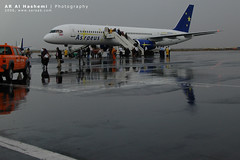It turned out that
the ambassador and her team on the hijacked plane were likely less stressed about the situation than those of us in Sanaa who just heard about it but weren't living it. It was the fear of the unknown that was so oppressive to us.
We didn't know, for example, if the hijacker had targeted the ambassador and her team or if it was coincidence that the plane he chose to hijack had so many representatives from the U.S. government aboard. So we started from the worst assumptions. My head was filled with images of hijackings from the 1970s and 80s where Americans were shot and dumped from planes onto the tarmac at airports where the planes had landed for refueling and where negotiations between the hijackers and the local government never seemed to get anywhere. Stories of how the other "lucky" passengers on the planes were treated, especially Americans whether they were with the military or government or not, still conjured up nightmares.
Fortunately, I didn't have to think about those scenarios for long. And then, once the plane returned to Sanaa, we heard about how things went on the plane from those who lived it. Their retelling of the tale provided us with great comic relief.
First, here is what they didn't know.
The hijacker was alone. He managed to get onto the plane when he arrived at the security checkpoint at the very last minute. He had a pen pistol hidden in his shoe which set off the metal detector as he walked through it. But once he was on the other side, he removed something from a pocket and said it must be what set off the detector. He handed it over to the security guard and rushed to the gate to get on the plane. The security guards didn't stop him. Remember, this was eight months before 9/11.
The hijacker didn't speak English. When he entered the cockpit, he explained in Arabic that he wanted the plane diverted to Baghdad. When the pilot and the crew realized he didn't understand English, they communicated with one another in English, giving instructions that appeared to comply with the hijacker's demands while actually setting up the means to subdue him. The pilot told the hijacker the plane would need to refuel if they were to fly all the way to Baghdad, so he diverted the plane to Djibouti. The pilot gave the crew instructions in English to be sure the passengers were not alarmed while he circled over the Red Sea as they formed a plan for subduing him. Once on the ground in Djibouti, the crew accomplished that by hitting him over the head with a fire extinguisher.
The hijacker didn't know there were official Americans on the plane. And he certainly didn't know that one of them was the U.S. ambassador to Yemen who had been the deputy chief of mission in Kuwait when four of Saddam Hussein's elite Iraqi Republican Guard divisions invaded that country. For the seven months Kuwait was occupied, the ambassador and the skeleton staff still in Kuwait were barricaded into the U.S. embassy. That experience colored many of her decisions when the embassy in Sanaa was ordered to evacuate non-essential personnel and dependents. But that is a different story.
Here is how the ambassador and others on the plane related the story as they realized something wasn't going according to plans.
The ambassador saw the hijacker go into the cockpit, but there were no announcements and there didn't appear to be any panic as flight attendants also entered the cockpit and returned to the passenger area without indicating there was anything alarming happening. But then she noticed that the Red Sea was on the wrong side of the plane. It should have been visible out of the windows on the right side of the plane as it headed south to Taiz, but she could see it out of the windows on the left side of the plane. Then she realized the flight was taking much longer than expected. She commented on this to the person sitting next to her, but neither of them were alarmed as there didn't seem to be anything else out of order.
When the plane landed in Djibouti, the flight attendants walked through the plane and quietly told the passengers they should all go to the back of the plane. Once they were in the back of the plane, the attendants explained that the plane had been hijacked, but they expected to get control of the situation, suggesting that everyone remain calm and quiet at the back of the plane.
The defense attache and one of General Franks' advance team members pointed out that there was an exit out the tail of the plane and suggested they should instead open it and leave the plane. They opened the exit and urged the ambassador to take off her shoes and exit using the inflatable ramp that opened up. The chief political officer told me that his first, but only very transitory, thought when he saw the exit door being opened was that now they were
really going to be in trouble because they weren't following the flight attendant's instructions. All the passengers were able to exit the plane.
Members of the U.S. embassy staff in Djibouti (two of them my former colleagues in Barbados) were at the airport when the plane landed. I imagine they all had similar nightmare scenes in their heads as the plane landed. What a relief it must have been to see the ambassador running across the tarmac toward the main building in her bare feet.
Did the hijacker see the passengers leaving the plane? Maybe. Maybe that was just the diversion the crew needed to knock him on the head.

 by bottled_void
by bottled_void 
 by Mycatkins
by Mycatkins 
 by saraabâ„¢
by saraabâ„¢
No comments:
Post a Comment